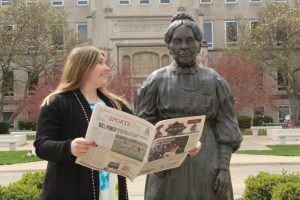The Scout this week profiled problems plaguing Lovelace Hall, one of three singles buildings located along St. James Street.
Furniture is crumbling, there might be mold, the floor sags and so do the lights. It’s an all-around mess.
Administrators this week placed the blame on residents who don’t treat the building all that well, and while that could easily be the case, we have a hard time believing each of the building’s residents are pulling lights out of the ceiling. We doubt each resident is beating the incredibly old furniture so badly that it falls apart. And we doubt each resident abuses the floors so much that they’re sagging beneath their weight.
The fact of the matter is, Bradley is the owner and maintainer of the building. It’s the landlord, and the building is in inexcusable shape. It’s easy for singles buildings to kind of fall off the radar because they house only a handful of students compared to the larger dorms. But they are still housing students, and those students still deserve livable conditions.
We’re not throwing around the word slumlord here, but it’s pretty bad over there, and while Bradley may blame the residents, we’re more inclined to blame Bradley.
But it’s not as if Lovelace is alone in this squalor.
Just about every building on campus has seen its fair share of problems. Many of those problems have been reported on in these pages over the last few years.
When the newest residence hall is more than 30 years old, you’re bound to have problems.
And that is the case on the Hilltop, where students are living in dorms that can be more than 50 years old. That’s older than some students’ parents.
Yikes.
We suppose, then, that it shouldn’t come as such a shock when we see these serious problems. And yet, it is surprising to see such poor living conditions at a top-rated, private university.
We’d be remiss if we didn’t point out the millions and millions Bradley has spent in the last five years to update the dorms, including adding air conditioning to every building except Heitz, which is due for a renovation this summer.
But we’d also be remiss if we didn’t look at that money as nearly wasted.
The dorms are still old.
They’re still ugly.
And, all too often, they’re still falling apart.
Bradley’s admissions reps are still recruiting students, all of us included, in spite of the dorms, not because of them. We’ll also give credit to the outstanding residential life staff – your RAs and ARAs – who make living in Bradley’s dorms a worthwhile experience in spite of all the issues.
What’s further alarming about this is that there doesn’t seem to be any solid plan about what to do to eradicate the housing issue.
Sure, the university is landlocked. The city of Peoria is hesitant to give the university any more room to grow.
Compounding the problem is the larger and larger freshmen classes pouring on campus each August. The university was hoping Main Street Commons would alleviate the over-crowding, but each week that ticks by makes that a less and less likely solution as the complex remains more than half-empty.
So we’d like to see a plan of attack. Where is the university going to build a new building so it can begin tearing down existing ones? There are possibilities, though, admittedly, none are all that appealing. But there’s got to be a solution somewhere, and it’s got to come down the pipeline quickly.
When the university moves on to the next capital campaign, the residence halls must be included.
Bradley’s falling behind. Future students are obviously going to care about top-notch academics, and that’s something Bradley can offer them.
Those same future students are also going to care about where they’re going to live. They’re going to care about having cool dorms where residents aren’t concerned about falling light fixtures.
And that’s just something Bradley can’t offer them right now.



